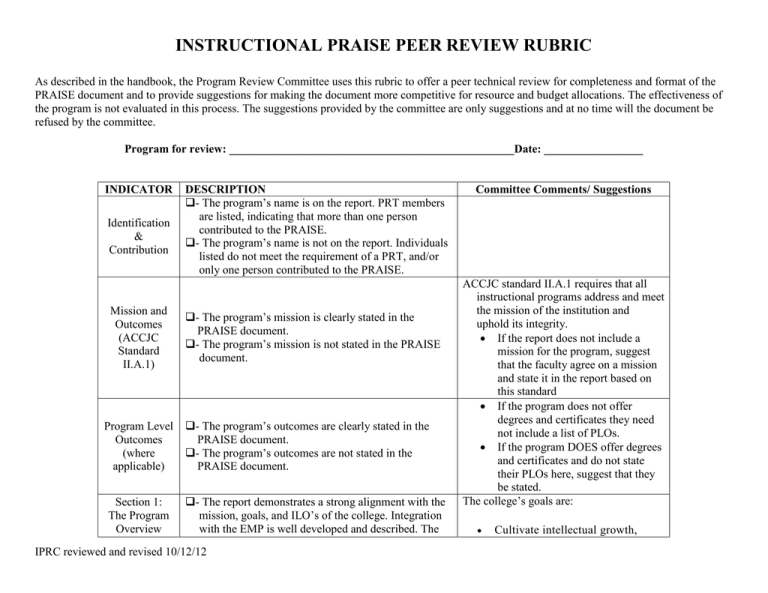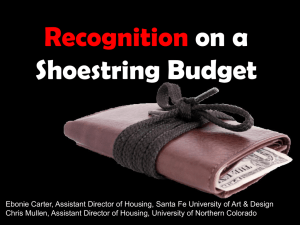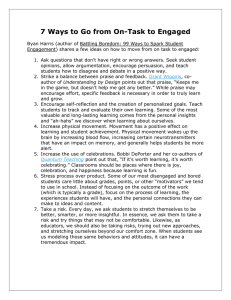INSTRUCTIONAL PRAISE PEER REVIEW RUBRIC
advertisement

INSTRUCTIONAL PRAISE PEER REVIEW RUBRIC As described in the handbook, the Program Review Committee uses this rubric to offer a peer technical review for completeness and format of the PRAISE document and to provide suggestions for making the document more competitive for resource and budget allocations. The effectiveness of the program is not evaluated in this process. The suggestions provided by the committee are only suggestions and at no time will the document be refused by the committee. Program for review: _________________________________________________Date: _________________ INDICATOR Identification & Contribution Mission and Outcomes (ACCJC Standard II.A.1) Program Level Outcomes (where applicable) Section 1: The Program Overview DESCRIPTION - The program’s name is on the report. PRT members are listed, indicating that more than one person contributed to the PRAISE. - The program’s name is not on the report. Individuals listed do not meet the requirement of a PRT, and/or only one person contributed to the PRAISE. - The program’s mission is clearly stated in the PRAISE document. - The program’s mission is not stated in the PRAISE document. - The program’s outcomes are clearly stated in the PRAISE document. - The program’s outcomes are not stated in the PRAISE document. - The report demonstrates a strong alignment with the mission, goals, and ILO’s of the college. Integration with the EMP is well developed and described. The IPRC reviewed and revised 10/12/12 Committee Comments/ Suggestions ACCJC standard II.A.1 requires that all instructional programs address and meet the mission of the institution and uphold its integrity. If the report does not include a mission for the program, suggest that the faculty agree on a mission and state it in the report based on this standard If the program does not offer degrees and certificates they need not include a list of PLOs. If the program DOES offer degrees and certificates and do not state their PLOs here, suggest that they be stated. The college’s goals are: Cultivate intellectual growth, (ACCJC Standard I.B.3, I.B.4) program has identified characteristics, progress, trends, improvements, and challenges. Discussion of planning amongst program members is well summarized. The report clearly discusses short term and long term planning. Goals are discussed or listed, and a plan for achieving them is clearly described. Goals strongly relate to program improvement and improvement of student success within the program. - The report demonstrates adequate alignment with the mission, goals, and ILO’s of the college. The report indicates some integration with the EMP. The program has identified some characteristics, progress, trends, improvements, and challenges. The report includes some evidence of discussion of planning amongst members. Goals are discussed or listed, and a plan for achieving them is adequately described. Goals adequately relate to program improvement and improvement of student success within the program. - The report demonstrates little or poor alignment with the college’s mission, goals, and ILOs. Little discussion of integration to the EMP or the program’s characteristics, progress, trends, improvements, and challenges (or accompanying discussion of planning by members) is present in the report. Goals are poorly discussed or listed, and a plan for achieving them is not clearly described. Goals poorly relate to program improvement and improvement of student success within the program. - The report demonstrates no alignment with the college’s mission, goals, and ILOs. No discussion of integration to the EMP or the program’s characteristics, progress, trends, improvements, and challenges (or accompanying discussion of planning by members) is present in the report. The report does not discuss short term and long term planning. Goals are not discussed or listed. Section 2: - The report clearly describes how the current faculty Faculty and and staff structure affects the program’s ability to IPRC reviewed and revised 10/12/12 social responsibility, environmental stewardship, cultural enrichment, and economic development. Create exceptional and accessible lifelong learning opportunities that afford students within our expanding communities the attainment of knowledge and skills necessary for success in the global economy. Embrace difference in our communities by integrating their wealth of multicultural knowledge and wisdom into a cohesive and resourceful learning environment for all. Inspire innovative teaching and service with imaginative uses of collaboration and technology, fostering vibrant programs that are measurably effective in addressing student learning and community needs. Empower each student to learn by modeling academic integrity, democratic citizenship, and meaningful contribution to society. If the report includes discussion of need for faculty or staff, but does not include Staff improve student success. Identification of changes within the structure is made and centered on improved student success. - The report describes the current faculty and staff structure, but it may not be directly linked to how it affects the program’s ability to improve student success. Identification of changes within the structure is made, but discussion of how it centers on improved student success is unclear. - The report does not adequately describe the faculty and staff structure or link it to student success. Little discussion of potential changes within the program to improve student success is present. - The report does not discuss faculty and staff structure. - The report identifies curriculum and instruction and their links to the college’s mission and goals. A clear discussion of curriculum and instruction updates, changes, planning, and improvement strategies exists in the report. The report describes the process of Section 2: evaluation of offerings and a summary of strengths Curriculum and weaknesses as a result. and - The report identifies some curriculum and instruction Instruction but may not describe their links to the college’s (ACCJC mission and goals. A discussion of some aspects of Standard curriculum and instruction such as updates, changes, II.A.2.c-e) planning, and improvement strategies exists in the report. The report may/may not describe the process of evaluation of offerings and a summary of strengths and weaknesses as a result. - The report poorly describes curriculum and instruction and little link to the college’s mission and IPRC reviewed and revised 10/12/12 a discussion as to how increasing the faculty/staffing structure will improve success of students within the program, suggest some of the following: 1. Is there difficulty in finding parttime faculty to teach a particular course that is necessary for a degree or certificate? 2. Does the classroom experience suffer due to lack of support (ex: laboratory prep) 3. Is there increasing demand for a course or courses that can be justified by research office data or internal/external data (see EMP) that supports the request for faculty? 4. Is there a new course in the program’s curricula that requires a new faculty with specific training? 5. other The report may contain a discussion that simply lists courses that have been updated. If so, suggest explaining how. Examples: Were teaching methodologies updated? Textbook selections? Were changes made based on assessment data? Were changes made based on industry requirements? Updates to include distance education options for students? If the report indicates that no review of curriculum has occurred, suggest that a goals are discussed. Little discussion of curriculum and instruction such as updates, changes, planning, and improvement strategies exists in the report. The report poorly describes the process of evaluation of offerings and a summary of strengths and weaknesses as a result. - The report does not describe curriculum and instruction and no link to the college’s mission and goals is discussed. No discussion of curriculum and instruction such as updates, changes, planning, and improvement strategies exists in the report. The report does not describe the process of evaluation of offerings and a summary of strengths and weaknesses as a result. - The report uses the PREs to describe and identify strengths, weakness and success in the report. The report also discusses the implementation of assessment and assessment results of SLOs and PLOs (where applicable) in the report There is evidence of robust discussion amongst faculty of PREs and assessments, what was learned from them as well as a plan for improvement, including student support Section 2: service needs and EMP goals. Program - The program uses some PREs to describe and Effectiveness/ identify strengths, weaknesses and success in the Success report. The report inadequately discusses the (ACCJC implementation of assessment and assessment results Standard of SLOs and PLOs (where applicable) in the report. I.B.3,5, There is evidence of some discussion amongst faculty II.A.1.a,c; of PREs and assessments, what was learned from II.A.2-4,6) them and some planning for improvement, including student support service needs and EMP goals, is not clear. - The report uses few PREs to describe and identify strengths, weaknesses and success in the report. The report provides little discussion of the implementation of assessment and assessment results of SLOs and PLOs (where applicable) in the report Little IPRC reviewed and revised 10/12/12 discussion of when the last time curriculum was reviewed and when it is planned to be reviewed in the future be included. The standards require that the institution make decisions based on data (qualitative and quantitative) and that assessment results are used to communicate matters of quality assurance. This applies to instruction. The standards also require that the institution use research data to identify student needs and outcomes and assesses progress towards achieving learning outcomes. Outcomes must be stated for all levels (course, program, etc) and that assessment results be used to make improvements at all levels. The Dialogue form was designed to address these requirements. Read through the responses and make suggestions, where needed, to meet the standards. discussion of the PREs or assessments, or what was learned from them for planning, exists in the report. - The report does not use PREs or assessment results to describe and identify strengths and weakness of student demographics and success in the report. No discussion for planning and improvement based on data is present. - Section 2: Facilities/ Technical Infrastructure and Resources - The report clearly describes the limitations of facilities, technical infrastructure, and resources that affect its ability to improve student learning and identifies changes and needs that would lead to improvement. - The report describes some limitations of facilities, technical infrastructure, and resources that affect its ability to improve student learning and identifies some changes and needs that would lead to improvement. - The report describes few limitations of facilities, technical infrastructure, and resources that affect its ability to improve student learning and identifies some changes and needs that would lead to improvement. - The report neither describes limitations of facilities, technical infrastructure, and resources that affect its ability to improve student learning, nor does it identify changes and needs that would lead to improvement. IPRC reviewed and revised 10/12/12 The standards require that facilities, equipment and other assets support student learning programs and improve institutional effectiveness. The institution must assure that any technology is designed to meet the needs of learning and is integrated with institutional planning. Program review is an integral aspect of institutional planning. The report should include detailed discussion of the program’s need for facilities/technology, etc. and how the acquisition would: o create learning improvement o enhance learning improvement o or maintain learning improvement If the report simply lists needs for this category suggest ways in which the author can relate the need to learning improvement and support the instructional program. Section 3: Needs Assessment - The report identifies that the current level of support (without increase or reduction) is sufficient. - The report lists resources needed to improve student success and provides clear and concise justification of the needs within the PRAISE report that is based on assessment and PRE data - The report lists resources needed to improve student success, but the justification of the needs based on assessment and PRE data must be more significant or more clearly described. - The report poorly identifies resources needed to improve student success, and little justification of the needs exists within the report. - The report neither identifies resources needed to improve student success, nor does it provide a justification of the needs within the report. Appendices (Five-Year Staffing Profile; PREs; Budget Worksheet) - The program provides all of the required appendix items for the PRAISE report. - The program does not provide the required appendix items for the PRAISE report. If the report does not justify each need by referencing data, suggest that it do so. This is part of planning, and planning must be data-driven. The data can be from the research office, from assessment, from internal or external scans (see EMP), or from internal program analysis, such as staffing profile and its effect on program efficiency, etc. If the report meets all of the highest levels, please indicate a job well done here! List of Abbreviations: EMP: Educational Master Plan ILO: Institutional Learning Outcomes PLO: Program Learning Outcomes PR: Program Review (the process of) PRAISE: the Program Review, Allocation, and Institutional Strategies for Excellence (document) PRAR: Program Review Area Representative IPRC reviewed and revised 10/12/12 PRE: Program Review Elements (data sets provided by the Institutional Research Office) PRT: Program Review Team SLO: Student Learning Outcomes IPRC reviewed and revised 10/12/12



